This month’s book list has been put together by Nicola Daly to celebrate the launch of a powerful wordless picture book by Issa Watanabe, Migrants.
Here are her recommendations for great wordless or silent picture books:
I am thinking a lot about silent picturebooks these days as the Waikato Picturebook Research Unit approaches its annual picturebook seminar on November 12, 2020, this year focusing on silent picturebooks.
Here I’d like to share some of my favourite wordless or silent picturebooks in the hope that this will encourage you to become familiar with silent books and their particular gifts.
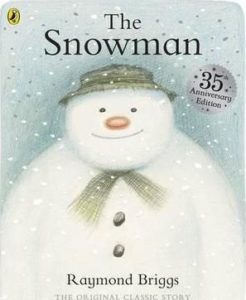 I have to start with Snowman by Raymond Briggs (Penguin, 1978), a story of a little boy who wakes to snow falling and goes out to make a snowman during the day. Then, during the night (and we’re never sure if it’s a dream) he invites the snowman into his home where they explore together. In return the snowman takes the little boy out flying in the night sky across to a faraway city and then back home.
I have to start with Snowman by Raymond Briggs (Penguin, 1978), a story of a little boy who wakes to snow falling and goes out to make a snowman during the day. Then, during the night (and we’re never sure if it’s a dream) he invites the snowman into his home where they explore together. In return the snowman takes the little boy out flying in the night sky across to a faraway city and then back home.
Raymond Briggs’s coloured pencil drawings are stunning; he uses a mixture of story panels and occasionally larger drawings which punctuate the story beautifully; double page spreads are used as the Snowman and the boy soar in the sky on their night time adventure. This is a magical encounter with possibilities for discussions of fantasy and cultural difference. It has also been made into an animated film (1982).
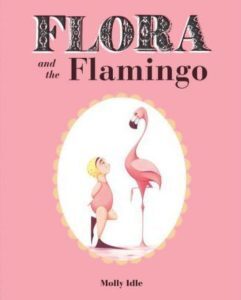 Molly Idle’s Flora and the Flamingo is a Caldecott Award winner (Chronicle, 2013). This is a story of a girl (Flora) in a pink bathing suit and flippers and a flamingo who meet, and, hesitantly at first, get to know each other through movement. They mirror each other’s body language, steal shy glances, and finally perform a graceful dance with each other.
Molly Idle’s Flora and the Flamingo is a Caldecott Award winner (Chronicle, 2013). This is a story of a girl (Flora) in a pink bathing suit and flippers and a flamingo who meet, and, hesitantly at first, get to know each other through movement. They mirror each other’s body language, steal shy glances, and finally perform a graceful dance with each other.
This wordless book captures the choreography of a new relationship beautifully using flaps to capture particular moments and reactions. The curved shapes, interactions between the two characters and the range of pinks framed by blossom on each page make this a visual delight, culminating in a joyous double page spread foldout as Flora and the flamingo reach the crescendo of their dance.
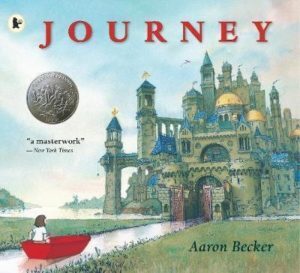 Journey by Aaron Becker is another Caldecott Honor Book (Candlewick Press, 2013). It is somewhat reminiscent of the classic Harold and his Purple Crayon by Crockette Johnson (Harper, 1955) in that the main character has a crayon (in this case a red crayon) which allows her to draw things which become real.
Journey by Aaron Becker is another Caldecott Honor Book (Candlewick Press, 2013). It is somewhat reminiscent of the classic Harold and his Purple Crayon by Crockette Johnson (Harper, 1955) in that the main character has a crayon (in this case a red crayon) which allows her to draw things which become real.
Journey begins with the main character drawing a red door to escape the grey drudgery of her home life where everyone in her family is too busy to play. She then takes a fantastic journey on a red boat, then a red balloon, and finally a red flying carpet. Towards the end, she is helped by the owner of a purple crayon, and we are prepared for Becker’s next silent picturebook adventure in a subsequent book, Quest. Becker’s style uses full page spreads rather than story panels of smaller frames. It is his use of colour which gives the story a thread and draws you through the exciting adventure across pages.
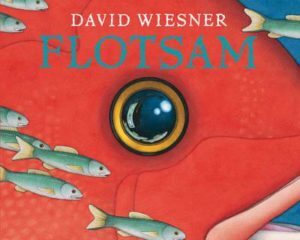 David Weisner’s Caldecott medal winner Flotsam introduces us to a boy on the beach looking at sea creatures and shells when he is thrown over by a rogue wave. When he comes to, an old fashioned underwater camera is at his feet. He shows his family who puzzle over it and then decide to have the film developed.
David Weisner’s Caldecott medal winner Flotsam introduces us to a boy on the beach looking at sea creatures and shells when he is thrown over by a rogue wave. When he comes to, an old fashioned underwater camera is at his feet. He shows his family who puzzle over it and then decide to have the film developed.
On the photos he sees images of a fantastical underwater world, and also a photo of another child, holding a photo of another children, holding another photo, and so on. Using a magnifying glass to examine the details of the photo, he realises he is part of a chain of recipients across many years. The story finishes as he takes his own photo and throws the camera back into the sea. The enagement of this story comes from the mystery of the camera, and the intrigue of the visual chain letter it transports.
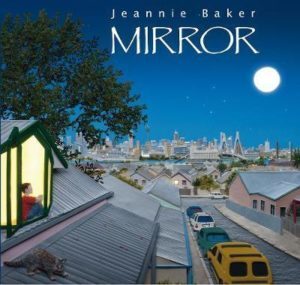 Jeannie Baker’s Mirror (Candlewick Press, 2010) is in a format I have not seen before or since. When the book is opened there are two chapters, one to the left featuring a family living in an Australian city, and one to the right featuring a family living in Morocco. Very cleverly, as the two chapters are opened simultaneously page by page, the images on the right mirror the images on the left, following family life in two different parts of the world.
Jeannie Baker’s Mirror (Candlewick Press, 2010) is in a format I have not seen before or since. When the book is opened there are two chapters, one to the left featuring a family living in an Australian city, and one to the right featuring a family living in Morocco. Very cleverly, as the two chapters are opened simultaneously page by page, the images on the right mirror the images on the left, following family life in two different parts of the world.
Comparing the two illustrations is made easy because, as for all books in a Western context, the chapter on the left opens right to left, and as for all books in an Arabic context, the right hand chapter opens left to right. On the first opening we see the morning rituals of each family and we see the Moroccan mother weaving a rug. We see both families eating breakfast and heading to work with many opportunities for readers to spot differences. Two markets are contrasted, and the rug we saw being woven is sold and metaphorically crosses the middle of the book from the Moroccan side to the Australian side when the Australian family purchase it. Jeannie Baker’s collage illustrations are incredibly detailed and the format of this picturebook as it tells the two stories is clever and sophisticated.
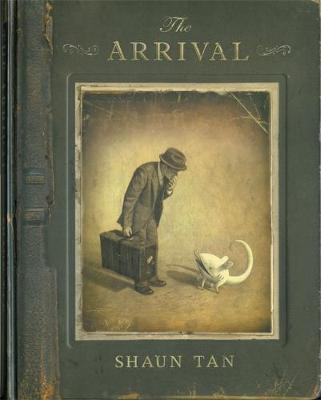 A list of silent picturebooks would not be complete without including Shaun Tan’s The Arrival (Lothian, 2006). The six chapters in this wordless picturebook tell the story of an immigrant who leaves his wife and child to travel in a large ship across many miles to a new land. We see the loneliness of the arrival, and the extreme strangeness of the new land he has arrived in. Writing is in strange script, people do strange things, buildings are odd, but amidst all of this there are moments of connection- friendly faces, people who help, shared stories.
A list of silent picturebooks would not be complete without including Shaun Tan’s The Arrival (Lothian, 2006). The six chapters in this wordless picturebook tell the story of an immigrant who leaves his wife and child to travel in a large ship across many miles to a new land. We see the loneliness of the arrival, and the extreme strangeness of the new land he has arrived in. Writing is in strange script, people do strange things, buildings are odd, but amidst all of this there are moments of connection- friendly faces, people who help, shared stories.
Tan’s work is presented in black and white pencil drawings, reflecting a myriad of stories which he says are in part based on stories from immigrants including his own Malaysian father who arrived in Australia in 1960. Tan uses a mix of large double spread detailed images, and tiny close ups of particular moments in story panels which add texture to the telling of this sad, moving, and ultimately hopeful story of moving to a new and very unfamiliar land.
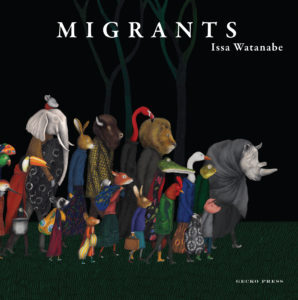 And lastly, I have to include my most recent favourite. Not just because it is a Gecko Press book! I found this book with its Spanish title Migrantes at the Guadalajara Book fair in December 2019 and then discovered that Gecko Press had bought the rights to publish it in English as Migrants (2020).
And lastly, I have to include my most recent favourite. Not just because it is a Gecko Press book! I found this book with its Spanish title Migrantes at the Guadalajara Book fair in December 2019 and then discovered that Gecko Press had bought the rights to publish it in English as Migrants (2020).
The story begins as we are introduced to a skeleton draped in floral cloth beside a large red beaked Ibis bird (a messenger between birth and death). The skeleton joins a group of anthropomorphised characters of various shapes and sizes, adults and children who are moving together through a gloomy forest. We know from the title that these are migrants; we know from the faces and clothing that this is not migration by choice—these are refugees with death (symbolised by the skeleton) close at their heels. The Peruvian author Issa Watanabe has said that her book is about empathy and through its pages we witness the journey of this group with insights into the experiences of refugees. We see the group move through a forest and then reach a body of water where they scramble into a boat and cross, losing a member along the way. Finally they come to a place where the trees have colour and there is a fruit on the ground—which I interpret as a symbol of hope. This book deals with complex topics including courage, loss and hope, and the images do this sensitively and powerfully.
The power of the wordless or silent book lies in the illustrations and how each reader is allowed to create their own words around those images.
This brief snapshot of some of my favourites shows that they can be light and humorous, but can also deal with very sophisticated and complex issues. They offer opportunities for interaction and meaning negotiation for a parent with a child, and a classroom teacher with a whole class.
Nicola Daly is a senior lecturer at Te Kura Toi Tangata, in the Division of Education at the University of Waikato where she teaches courses in children’s literature and language learning. Her courses An Introduction to Children’s Literature and New Zealand Children’s Literature are both offered online.
Nicola’s research examines the use of languages in picturebooks; she has had fellowships at the Marantz Picture book Collection at Kent State University, the International Youth Library in Munich, Germany, and most recently was a Fulbright New Zealand Scholar based at the Worlds of Words Center, University of Arizona, USA.
She runs a picturebook club for University of Waikato staff and students and is the Co-Director of the Waikato Picture Book Research Unit which runs an annual seminar at the Hamilton Campus. This year the seminar is on Silent Picturebooks and will take place on 12th November. Register here.
Also from 2nd to 27th November this year the IBBY Silent Book Collection will be on display at the University of Waikato Library, and members of the public are welcome to attend.
Migrants is available now from wherever you buy or consume your books and on our website.
Want to hear more from Gecko Press? Every month we send out a newsletter with all of our latest blog articles, book lists, activity sheets, and sometimes a competition too! Sign up to our mailing list here.

